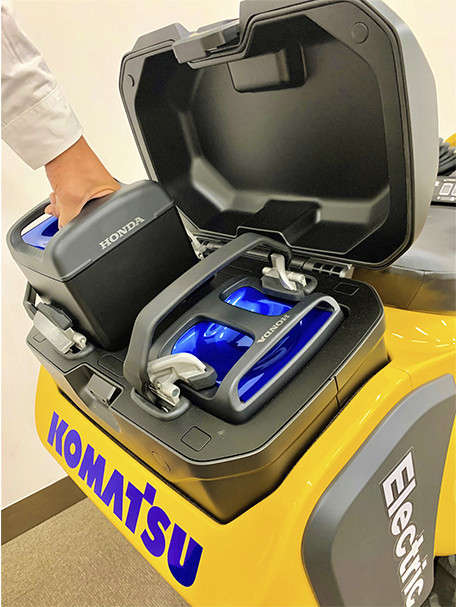Many companies are pledging to meet environmental, energy, and emissions goals established by the Paris Accord. Others are setting their own pace, based on their exposure to public and governmental scrutiny. Factories and office complexes are a natural target for environmental changes and the progressive companies are working their R&D departments to make necessary changes to the product line alongside making changes to the company itself.
Komatsu, a major construction equipment manufacturer, has put forth a long-term goal for 2050 of achieving carbon neutrality, or virtually zero carbon emissions, along with a commitment for 2030 to half CO2 emissions from product operations, from their levels in 2010, and to increase the rate of renewable energy they use to 50%. In addition, Komatsu will deploy the relevant technologies at material suppliers and other partners to help them also achieve carbon neutrality in their operations.
But facility management is only part of the equation. Komatsu is also adopting a two-pronged approach toward its own equipment line. With about 90% of the total CO2 being emitted by products in use, the first prong is to increase the equipment’s work and fuel efficiency, and to transition from diesel and other internal combustion engines to cleaner power sources, including hybrid and electric engines and fuel cells.
The second prong is the improvement of processes. CO2 emissions will be lowered by optimizing customers’ workplace operations and processes, to reduce the amount of equipment needed along with actual operating hours. Komatsu is, for instance, committed to optimize construction by evolving its Smart Construction solution, to expand the forestry machinery business, which supports a sustainable forest management cycle of planting, cultivating, and harvesting, and to strengthen its Reman operations, used by Komatsu to remanufacture, and reuse components.
In implementing its policies for carbon neutrality at production bases, Komatsu will prioritize conservation initiatives for reducing energy consumption through production technology, then energy generation initiatives for producing renewable energy in-house, and, lastly, by purchases of renewable energy.
History Lesson
One of the first steps in changing its product line was taken years ago. Komatsu is one of the largest mining equipment manufacturers; its product range including dump trucks, dozers, wheel loaders, rope shovels, and hydraulic excavators for the mining industry. Komatsu Germany Mining started to build the first hydraulic mining excavator driven by an electric motor in the early 1980s.
Now, almost 40 years later, Komatsu has delivered more than 250 electric driven hydraulic excavators worldwide. With over 7 million operating hours, Komatsu is one of the most experienced and most successful companies developing, manufacturing, and maintaining this type of machine.
The unique advantage of the electrically driven hydraulic excavator lies in the reduced operating costs, made possible by the elimination of diesel costs and the fact that they are not obliged to comply with any emission regulations. With the new PC4000-11 electric drive, Komatsu shows its experience, knowledge and its many years of developing, manufacturing, and maintaining electric driven hydraulic excavators.

Taking the electric drive concept to another extreme is the PC01E-1 electric micro excavator developed jointly by Komatsu and Honda. The partners created the PC01E-1 by successfully electrifying the PC01 conventional micro excavator through the incorporation of the Honda Mobile Power Pack e:, a swappable battery, and Honda eGX electrified power unit.
Why the PC01? The conventional model is typically used very close to people, trees and buildings for pipe-laying, agriculture, livestock and the like. As a result of electrification, the PC01E-1 model not only reduces noise and exhaust heat substantially, but also enables eco-friendly, comfortable work in either indoor or outdoor environments, thanks to no exhaust gas.
As the batteries are swappable, customers can continue work simply by exchanging them. The new electric motor offers high performance even in low revolutions, so the PC01E-1 model achieves more excavation than the conventional model in low revolutions. As there is no engine installed, customers will no longer need engine-related maintenance or fueling, reducing daily inspection and maintenance work.
Main features of the PC10E-1
- No exhaust gas and no engine noise because it is battery powered. Thanks to its electric motor, which is capable of high performance, even in low revolutions, it enables stable, powerful work regardless of motor revolutions, offering more power output than conventional models in low revolutions.
- Easy exchange and charging of the swappable Honda Mobile Power Pack e: batteries by anyone. Customers can continue work by exchanging the batteries, which eliminates waiting time for charging. Charging is also easy and convenient because its exclusive charger connects to the 100V household power supply source.
- The new, exclusive, simple, stylish control panel displays the battery charge level in big letters in the center of the monitor screen.
- All engine-related maintenance work is no longer necessary, such as filter cleaning and fueling. Greasing is not necessary because oil-free bushings are used in its work equipment like in the conventional model. Daily inspection and maintenance work is substantially reduced.
Electrification of construction equipment is a major step toward emissions control. As more companies move their product line to renewable and non-fossil fuel energy, the world will benefit along with the companies that employ the technology.
Want to tweet about this article? Use hashtags #construction #sustainability #infrastructure #IoT #cloud #edge #futureofwork


